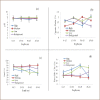Soil Pollution by Toxic Metals near E-waste Recycling Operations in Ibadan, Nigeria
- PMID: 30524795
- PMCID: PMC6221485
- DOI: 10.5696/2156-9614-6-11.26
Soil Pollution by Toxic Metals near E-waste Recycling Operations in Ibadan, Nigeria
Abstract
Background: Unsound recycling of e-waste releases toxic metals into environmental media and has deleterious health consequences to humans as the metals transfer to humans through the food chain, direct contact and inhalation.
Objectives: This study assessed soil contamination with lead (Pb), copper (Cu), chromium (Cr), nickel (Ni) and cadmium (Cd) arising from crude e-waste recycling.
Methods: Forty-eight soil samples were collected from the vicinity of high-, medium- and low-activity recycling operations in Ogunpa in Ibadan, Nigeria as well as from the botanical garden of the University of Ibadan for background samples. Total extractable metals were leached with aqua regia and the leachates were analyzed using flame atomic absorption spectrometry. Speciation analysis was also conducted on soil samples that showed high concentrations of metals to determine the distributions in various phases.
Results: All soil samples were determined to be sandy loam in composition with pH and organic matter ranging from 7.1-7.9 and 1.56-1.81%, respectively. Metal concentrations (mg/kg) for soils from the study area ranged as follows: Pb, 269 - 5650; Cu, 203 - 3483; Cr, 3.30 - 42.4; Ni, 0.14 - 24.0; and Cd, below detection limit - 2.50. The results indicated enrichment in soil by all metals, especially Pb and Cu, which were many times higher compared with background concentrations. Additionally, average Pb and Cu concentrations were higher than regulatory limits for soil set by selected countries across the globe. Speciation studies indicated that about 65% and 88% of Pb and Cu, respectively, were liable to potential mobility with slight changes in natural conditions. Other metal concentrations, although with higher concentrations compared with background levels, were within the permissible limits in soils accepted by many countries across the globe. There were significant correlations between all metals, suggesting that they may have been released from a common source.
Conclusions: Soils from the study area require urgent clean-up, especially for Pb and Cu, to safeguard human health and the environment.
Keywords: E-waste; recycling; soil; speciation; toxic metals.
Figures
References
-
- Solving the E-Waste Problem (StEP) UNU/StEP initiatives; 2012. What is e-waste? http://www.step-initiative.org/index.php/Initiative_WhatIsEwaste.html Accessed January 07, 2016.
-
- Das A, Vidyadhar A, Mehrotra SP. A novel flow sheet for the recovery of metals values from waste printed circuit boards. Resour Conserv Recy [Internet] 2009;53:464–69. [Cited 2016 Aug 10] Available from: http://www.sciencedirect.com/science/article/pii/S092134490900055X Subscription required to view.
-
- Menad N. Cathode ray tube recycling. Resour Conserv Recy [Internet] 1999;26:143–54. [Cited 2016 Aug 10] Available from: http://www.sciencedirect.com/science/article/pii/S0921344998000792 Subscription required to view.
-
- Bonn, Germany: StEP [Internet]; 2009. E-waste take-back system design and policy approaches; p. 24. [cited 7 Jan 2016] p. Available from: http://www.step-initiative.org/files/step/_documents/StEP_TF1_WPTakeBack....
-
- Sinha-Khetriwal D, Kraeuchi P, Schwaninger M. A comparison of electronic waste recycling in Switzerland and in India. Environ Impact Assess [Internet] 2005;25:492–504. [Cited 2016 Aug 10] Available from: http://www.sciencedirect.com/science/article/pii/S0195925505000521 Subscription required to view.
LinkOut - more resources
Full Text Sources



